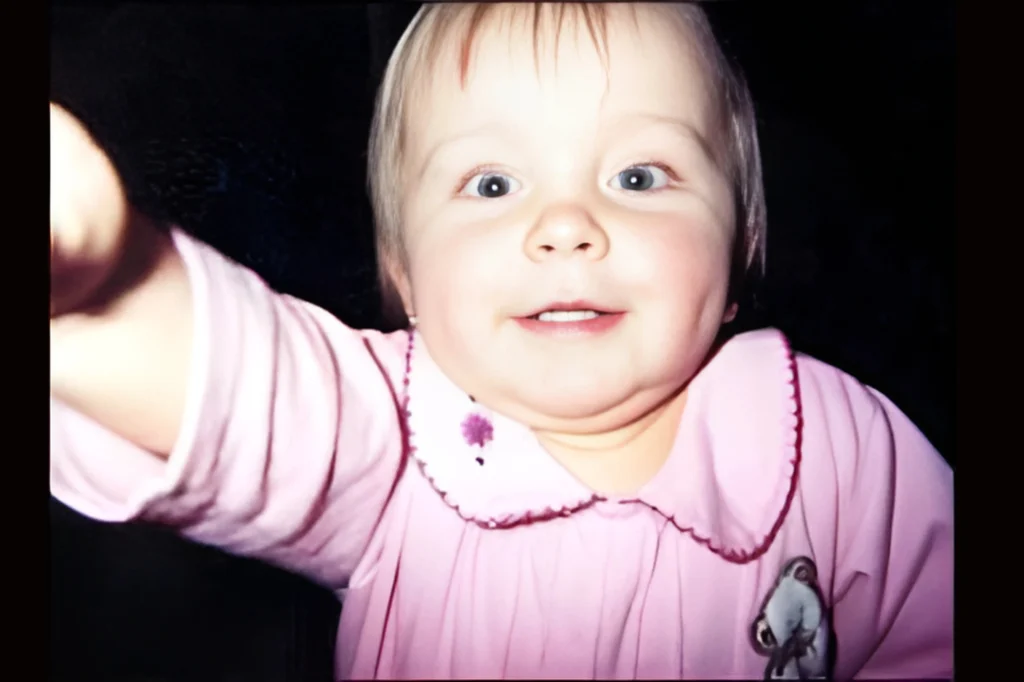On May 25, 2003, Salt Lake City, Utah, was supposed to be enjoying a peaceful Memorial Day weekend. But by that evening, the life of a one-year-old girl named Acacia Patience Bishop became the focus of a desperate search that stretched across state lines.
What began as a supervised visit between a grandmother and her granddaughter ended with an abduction.
The Early Signs No One Could Ignore
Acacia was born on October 19, 2001. She was small, with blonde-to-auburn hair and bright blue eyes, a child whose presence softened the tension in a family that had already endured its share of hardships. But there were warning signs long before that fateful day in 2003.
In 2002, Acacia’s grandmother, Kelly Jean Lodmell, took her without permission and hid her in a basement for over an hour. The incident rattled everyone, though it stopped short of signaling the disaster ahead.
According to CBS News, Kelly, born in 1965, struggled with paranoid schizophrenia and had a troubling past. In 1999, she was arrested for the aggravated assault of a police officer.
The Night Everything Changed

Memorial Day, 2003, started without alarm. Acacia was at her great-grandmother’s home, her parents away at a wedding rehearsal. Kelly was there under the pretense of a visit, with the great-grandmother nearby to supervise.
But sometime around 6 p.m., Kelly seized her chance. When the great-grandmother left the room, she walked out with Acacia.
That decision set the clock ticking. By nightfall, she had left Utah and crossed into Idaho Falls, Idaho, where she checked into a hotel near the Snake River.
For hours, no one knew where the toddler had gone and by the time authorities were alerted, Kelly was already preparing for the darkest act of the story.
On the morning of May 26, 2003, Kelly attempted a murder-suicide. She leapt into the Snake River with Acacia in her arms.
Workers at a nearby power plant spotted Kelly after she resurfaced. What she told them shook even the most hardened of rescuers: “She told us she lost the baby near the river… We shut down everything and called for help immediately.”
Authorities moved quickly, halting the plant’s water intake system and launching a massive search.
Twelve dive teams combed the Snake River in the following days, fighting swift currents and poor visibility. But despite the scale of the effort, Acacia’s body was never found, per Deseret News.
The Question No One Could Answer

With no remains recovered, investigators couldn’t close the book on the case. One theory was that Kelly had gone into the river with Acacia and lost her grip. Another, far stranger, possibility was that she had handed the baby off to someone else before the leap.
This suspicion gained traction when witnesses at the Red Lion Hotel in Idaho Falls reported seeing a man the morning after Acacia disappeared.
He was described as being in his early 40s to 50s, about 5’6” tall, with graying, sun-bleached hair, hazel eyes and a small, wiry build, according to Tapatalk.
His weathered, tan skin suggested a life spent outdoors. He had large hands with carrot-shaped fingers and was known to smoke “Basics” cigarettes.
He was never identified but investigators wanted to question him. If he had any connection to Kelly’s movements that morning, it could have changed everything.
From Tragedy to Courtroom

Initially, authorities thought Kelly might have simply stumbled into the river with Acacia in her arms. But as evidence came together, it pointed more strongly toward a murder-suicide attempt.
The investigation expanded from Salt Lake County to Idaho, tracking Kelly’s movements and collecting whatever scraps of information surfaced. When she was taken into custody, prosecutors filed charges of kidnapping and first-degree murder.
But in 2005, the case turned. A Utah court ruled her not guilty by reason of insanity, declaring that her mental illness had dictated her actions. Kelly was committed to a mental institution in Texas, the ABC4 Utah reports.
Richard Lambert, an assistant U.S. attorney, underscored the danger she posed: “Miss Lodmell was or is a very disturbed individual and a highly dangerous individual.”
His blunt statement echoed what many in law enforcement already believed—Kelly’s mental instability had put her granddaughter in unimaginable danger.
Still Missing
Amid the legal battles and theories, Acacia herself must not be forgotten. She was described as 2 feet 6 inches tall, with blue eyes and blonde to sandy auburn hair.
She had a large birthmark on her abdomen, the size of a tennis ball, a mole near the bridge of her nose by her left eye, and pierced ears.
On the day she disappeared, she wore a pink sundress patterned with white daisies.
Despite everything, Acacia’s fate has never been confirmed. She remains listed in the National Missing and Unidentified Persons System under case number MP1863, and in The Doe Network as case 3686DFUT.
The CUE Center for Missing Persons continues to encourage tips, keeping their hotline open around the clock. For families of missing children, even a faint thread of hope matters.
Two decades later, the disappearance of Acacia Patience Bishop continues to unsettle anyone who stumbles across her story. The central question—what really happened to Acacia—remains painfully open.
How Does Mental Illness Affect Criminal Responsibility?
When we think about crime, we usually picture a clear line: someone does something wrong and the law steps in. But in reality, that line blurs when mental illness comes into play.
Courts don’t just look at what happened. They also ask why. And sometimes, the “why” is rooted in something far more complicated than greed, anger or revenge.
In the United States, the idea of criminal responsibility rests on whether a person had the mental capacity to understand what they were doing and whether it was wrong.
Sounds straightforward, right? Except it isn’t. When someone is living with schizophrenia, bipolar disorder or another serious psychiatric condition, their ability to see reality itself can collapse. So, how do you punish someone who might not even realize what’s going on?
What Criminal Responsibility Means
To hold someone legally responsible, the court has to be convinced that they had the state of mind — what lawyers call mens rea — to commit the crime.
Think of it this way. A person who plans a bank robbery knows exactly what they’re doing. That’s intention. But someone who has a psychotic break and lashes out violently might not understand the nature of their actions at all.
Judges and juries weigh those differences carefully. As the American Bar Association explains, criminal responsibility hinges on whether the defendant could “appreciate the nature and quality or wrongfulness of their acts.”
If mental illness blocks that ability, accountability becomes a legal gray zone.
It’s not just black and white, courts look at shades of mental state. Was the crime intentional? Reckless? Negligent? Each carries a different level of blame.
And if mental illness disrupts that thought process, the law can’t treat it the same way it would treat a clear-headed decision.
The Insanity Defense
Most people have heard of the insanity defense but Hollywood and TV often twist it into something it’s not. It’s not a “get out of jail free card.” In fact, it’s one of the toughest defenses to pull off in American courts.
Under the famous M’Naghten Rule (yes, a 19th-century case from England still drives U.S. law), a defendant is insane if they either didn’t understand what they were doing or couldn’t tell right from wrong. That’s the gold standard in most states.
But not all states play by the same rules. Some follow the Model Penal Code which says it’s enough if the person couldn’t “conform their conduct to the requirements of the law.”
Translation: even if they sort of knew what they were doing, their mental illness may have made them powerless to stop themselves.
And then there are states that take a harder stance. In places like Montana and Kansas, the insanity defense has been eliminated altogether.
Instead, courts rely on verdicts like “guilty but mentally ill” which means the person goes to prison but with treatment attached. Some say it’s unfair, others say it stops people from abusing the insanity defense.
How Courts Actually Decide
So, how does a courtroom figure all this out? Enter the experts. Psychologists and psychiatrists are often called in to evaluate the defendant.
Their job is to dig into the person’s history, diagnose any conditions and answer the big question: did this mental illness directly affect their ability to understand their actions?
These evaluations aren’t casual check-ins. They can involve long interviews, psychological tests, even a deep dive into old medical records.
According to the American Psychological Association, forensic assessments may look at everything from cognitive function to impulse control. The findings don’t just shape verdicts. They influence sentencing and whether the person ends up in a hospital or a prison.
After the 1981 shooting of President Ronald Reagan by John Hinckley Jr. (who was found not guilty by reason of insanity), the public outrage was huge.
In response, Congress passed the Insanity Defense Reform Act of 1984. It made it way harder for people to say they were insane to get out of trouble in federal court.
Now, defendants have to prove their case with “clear and convincing evidence.” A much higher burden than before. It also narrowed the definition of insanity making sure only the most severe mental disorders qualified. This law still shapes federal trials today.
Beyond Insanity
The law doesn’t stop at insanity. There are other key legal tools:
- Diminished Capacity – This means mental illness doesn’t excuse the crime but it can lower the charges. Like, instead of murder someone might get manslaughter because they couldn’t fully form intent.
- Competency to Stand Trial – A defendant has to understand the court process and be able to help their lawyer. If they can’t, the trial gets paused until they’re stabilized. Under 18 U.S.C. § 4241, federal courts require these competency checks.
- State Statutes – Different states make their own rules. Like in California, there’s a law called Penal Code § 25(b) that talks about the insanity defense. In New York, the rules say some people have to get checked out by doctors to see if they’re okay to be in court.
Each of these reflects the balancing act: protecting society while also protecting the rights of someone whose illness distorts their reality.
Mental Illness and Sentencing
When a person is found guilty but mentally ill, the court has a tough job. Do they go to prison? Do they go to a hospital? Often, it’s both. Many states allow for treatment first in a psychiatric facility, followed by time in prison if necessary.
Some states also have mental health courts. These are special courts designed to handle cases where mental illness plays a big role.
Instead of just handing down punishment, they try to find solutions — like treatment programs, conditional release, or monitored care. It’s an attempt to keep people from cycling endlessly between jail and psychiatric hospitals.
Mental illness doesn’t affect all cases the same way. Take a look:
- Homicide cases – These are the most likely to involve an insanity defense. The stakes are life or death and juries are asked to weigh whether the killing was driven by delusion or conscious choice.
- Sexual offenses – In these cases, doctors might check someone’s mental health to see if they’re able to go through a trial. Sometimes, if their illness really affects them, the charges can be lowered because they didn’t fully understand or control what they were doing.
- Drug-related crimes – Many defendants struggle with co-occurring disorders. Courts sometimes redirect these cases toward treatment programs instead of just punishment.
Rights of Defendants with Mental Illness
Mentally ill defendants aren’t left without protection. They’re guaranteed the right to a lawyer, the right to treatment and protection under the Eighth Amendment which bans cruel and unusual punishment.
On top of that, the Americans with Disabilities Act (ADA) requires prisons and jails to provide reasonable accommodations, from access to medication to specialized care.
The system isn’t perfect. Critics argue that prisons often fail to meet these standards but legally, the protections are there.
At the end of the day the conversation about mental illness and criminal responsibility is about more than statutes and rules. It’s about the clash between accountability and compassion.
Courts have to decide whether someone acted with clear intent or whether their illness turned them into a danger even to themselves.
Mental illness doesn’t erase the harm done but it changes how we think about responsibility.
The law, messy as it is, keeps trying to answer the hardest question: when the mind breaks, how do we measure guilt?




